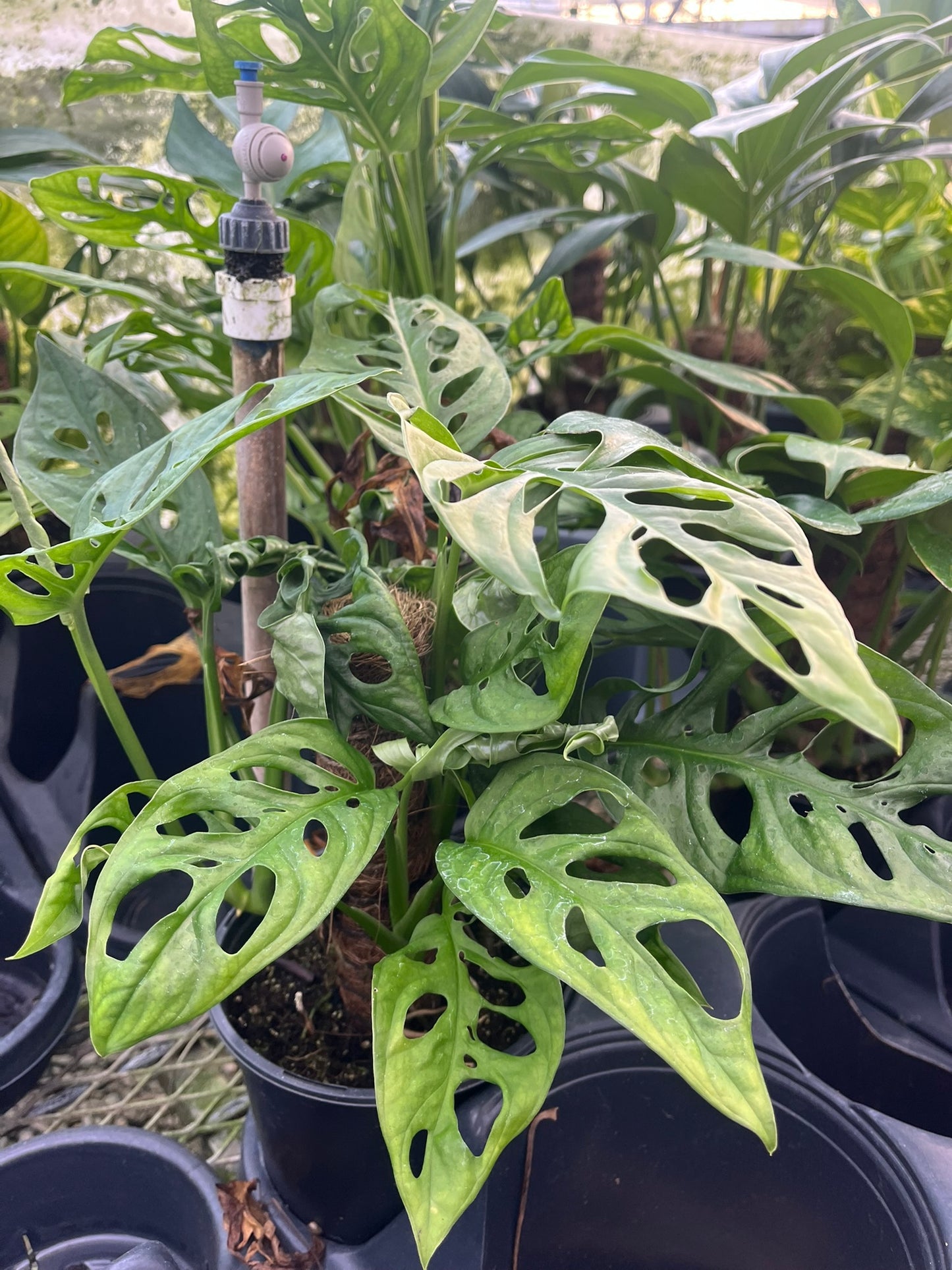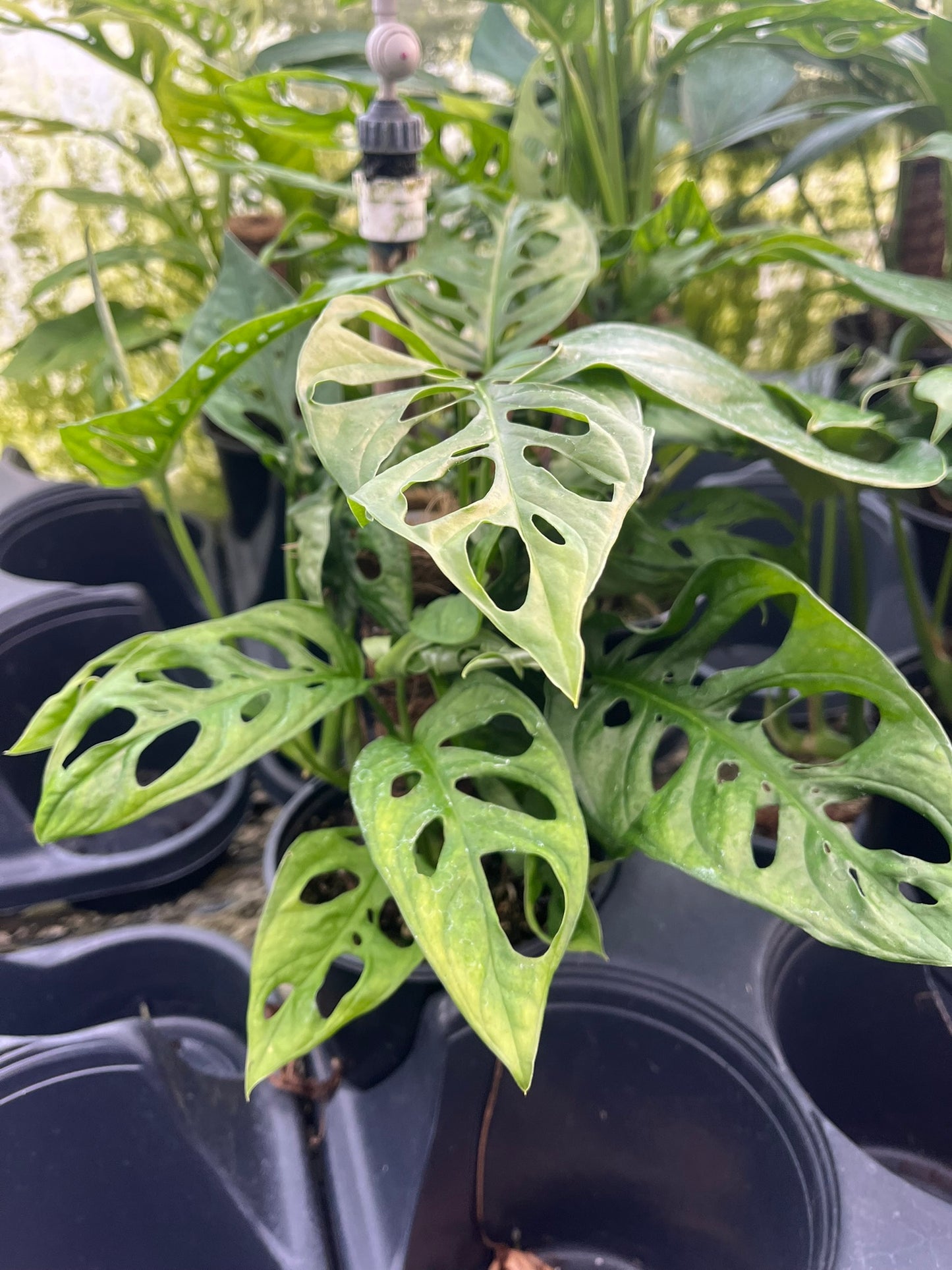Plant Hoarder
Monstera adansonii, Swiss Cheese Plant
Monstera adansonii, Swiss Cheese Plant
Couldn't load pickup availability
Share
Hardiness Zone:9
Sun Exposure:Part Sun, Mostly Shade and Shade
Monstera adansonii (Swiss Cheese Plant): A Playful Climber You’ll Love
Meet a houseplant that brings instant joy. Monstera adansonii, also called the Swiss Cheese Plant, has leaves with cute holes. The look is bold. The care is simple. And the vibe is pure tropical. In other words, it’s a must-have for your space.
Why We’re Obsessed
We love plants that do more with less. This one does it all. The leaves are light and full of holes. So the plant looks airy, not heavy. It climbs. It trails. It fits small rooms. It fills big rooms. But most of all, it keeps growing and changing. That’s exciting to watch.
Fast Facts (At a Glance)
-
Botanical name: Monstera adansonii
-
Also known as: Swiss Cheese Plant, Monkey Mask
-
Growth style: Climber or trailer
-
Mature size indoors: 3–8 ft with support
-
Light: Bright, indirect light
-
Water: When the top inch feels dry
-
Pet safety: Not safe for pets (like many aroids)
-
Skill level: Beginner-friendly
What Makes It Special
Those Iconic Holes
The “cheese” look comes from natural holes in the leaves. These holes are called “fenestrations.” They give a fresh, modern feel. They also let light pass through. Your plant looks lush without blocking your view. Instead of big, solid leaves, you get texture and movement.
A Flexible Habit
Let it trail from a shelf. Train it to climb a moss pole. Drape it across a window. You get options. After more than a few weeks in good light, you’ll see faster growth. You can shape it to fit any style.
Easy Care, Big Payoff
This plant doesn’t need fuss. A good soak. Bright, soft light. A little food now and then. That’s it. In other words, you get high impact with low effort.
Detailed Care Guide
Light
Place it in bright, indirect light. Think near a window with sheer curtains. Soft morning sun is fine. Avoid hot, direct mid-day sun. It can burn the leaves. If light is too low, new leaves may get small and may have fewer holes.
Pro tip: Rotate the pot each week. The plant will grow straighter and fuller.
Water
Water when the top inch of soil is dry. Stick your finger in to check. If it feels dry, water slowly until extra water drains out. Empty the saucer. If the leaves droop, it may be thirsty. If the tips turn yellow and the soil is soggy, that’s too much water. Instead of guessing, use the touch test.
Humidity
This plant loves moderate to high humidity. Normal home air is okay. But it will thrive with a little more moisture. A small humidifier helps. Or place the pot on pebbles with water below the pot line. In other words, keep the air comfy, not swampy.
Temperature
Keep it in the 65–85°F range. Avoid cold drafts and hot vents. Steady is best.
Soil
Use a well-draining mix. A blend for aroids is perfect. You can make your own: potting soil + perlite + bark. The roots need air. Heavy soil stays wet and can cause rot.
Fertilizer
Feed lightly during spring and summer. A gentle, balanced liquid plant food every 4–6 weeks works well. Skip winter feedings. Growth slows then.
Repotting
Repot every 12–18 months or when roots circle the pot. Move up 1–2 inches in pot size. Instead of jumping to a huge pot, take a small step. This keeps roots happy and soil fresh.
Training & Support
Give it something to climb. A moss pole, stake, or trellis is great. Tie stems loosely with soft ties. As it climbs, leaves often get bigger and may form more holes. You can also let it trail in a hanging pot for a waterfall effect.
Pruning
Trim long vines to shape. Cut just above a node (the bump where leaves grow). New growth will branch from there. Save the cuttings for propagation.
Propagation (So Easy)
Cut a vine with one or two nodes and a leaf. Place it in water or a moist, airy mix. Keep warm and bright, out of direct sun. Roots form in a few weeks. Plant in soil when roots are a few inches long. After more than one try, you’ll see how simple it is.
Common Questions (Quick Answers)
Why aren’t there holes in the new leaves?
Usually light is the reason. Move it to brighter indirect light. Give it a support to climb. New leaves often improve.
Why are the tips brown?
Likely dry air or underwatering. Boost humidity and water on time. Trim the dry tips if you like.
Why are the leaves yellow?
Often too much water. Let the top inch dry before you water again. Check that the pot drains well.
Is it safe for pets?
No. Like many aroids, it is not pet-safe if chewed. Keep it out of reach of cats and dogs.
Where It Shines in Your Home
-
Living room showpiece: Train it up a pole beside the sofa.
-
Shelf drama: Let vines pour down a bookcase.
-
Bright bathroom: Warmth and humidity boost growth.
-
Home office: Clean look. Calm energy. Easy joy.
In other words, it fits almost anywhere with soft light and steady care.
Style Ideas We Love
-
Modern minimal: White pot. Clean lines. Lots of negative space.
-
Tropical cozy: Woven basket. Moss pole. Group with ferns and pothos.
-
Boho trail: Macramé hanger. Long vines. Sun-washed wall.
-
Statement climb: Tall trellis. Floor planter. Big leaves, big impact.
What You’ll Receive
-
A healthy Monstera adansonii grown with care
-
Potted in a nursery pot for easy transfer
-
Fresh growth points ready to climb or trail
(Note: Plant size varies by season. Each one is unique. Expect natural leaf variation. Some leaves have more holes than others.)
Care Checklist (Pin This!)
-
Bright, indirect light
-
Water when top inch is dry
-
Boost humidity for best leaves
-
Use airy, fast-draining mix
-
Feed lightly in spring and summer
-
Train on a pole or let trail
-
Propagate from node cuttings
-
Keep away from pets
Why Choose This Plant With Us
We care about easy wins. We choose strong starts. We ship with care. We support you after your plant arrives. You get simple tips, fast help, and friendly tone. Instead of feeling unsure, you feel ready. That’s the goal.
Your First Week Plan
Day 1–2: Unbox gently. Water only if the soil is dry. Place in bright, indirect light.
Day 3–5: Let it settle. No repot yet. Watch leaves for signs of stress.
Day 6–7: If growth looks steady, plan your support (pole or hanger). Start a light mist in the morning if your air is dry.
After more than a week, you’ll see the plant relax. New leaves follow. You’ll smile. Promise.
Tiny Troubleshooting Map
-
Droop + dry soil: Water deeply.
-
Droop + wet soil: Let it dry longer between waterings.
-
Pale leaves: Needs more light or a gentle feed.
-
No growth: Warmer temps and brighter light help.
-
Spots after sun: It got direct sun. Move it back a bit.
Ready to Grow Together?
We want this plant to bring daily joy. We’re here to help you get there. With the right light, water, and love, Monstera adansonii becomes a living art piece. It’s easy. It’s fun. It’s you.
Lush Leaves, Happy Hearts




